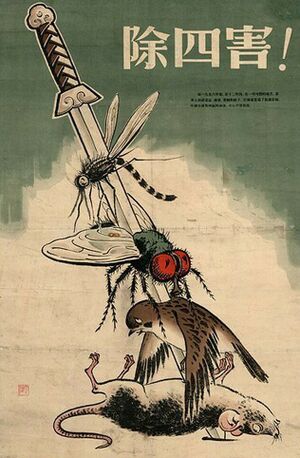حملة الآفات الأربع
حملة الآفات الأربع (الصينية: 除四害; پنين: Chú Sì Hài), was one of the first actions taken in the Great Leap Forward in China from 1958 to 1962. Authorities targeted four pests for elimination: rats, flies, mosquitoes, and sparrows. The extermination of sparrows - also known as the smash sparrows campaign[1] (الصينية: 打麻雀运动; پنين: dǎ máquè yùndòng) or the eliminate sparrows campaign (الصينية: 消灭麻雀运动; پنين: xiāomiè máquè yùndòng) - resulted in severe ecological imbalance, being one of the causes of the Great Chinese Famine of 1959-1961. In 1960 the campaign against sparrows ended and bed bugs became an official target.
الحملة

The "Four Pests" campaign was introduced in 1958 as a hygiene campaign aimed to eradicate the pests responsible for the transmission of pestilence and disease:
- the mosquitos responsible for malaria
- the rodents that spread the plague
- the pervasive airborne flies
- the sparrows—specifically the Eurasian tree sparrow—which ate grain, seed, and fruit[2]
العصافير
Sparrows were suspected of consuming approximately 2 kg (4 pounds) of grain per sparrow per year.[3] Sparrow nests were destroyed, eggs were broken, and chicks were killed. Millions of people organized into groups, and hit noisy pots and pans to prevent sparrows from resting in their nests, with the goal of causing them to drop dead from exhaustion.[3][4] In addition to these tactics, citizens also simply shot the birds down from the sky.[5] The campaign depleted the sparrow population, pushing it to near extinction within China.[5]
Some sparrows found a refuge in the extraterritorial premises of various diplomatic missions in China. The personnel of the Polish embassy in Beijing denied the Chinese request of entering the premises of the embassy to scare away the sparrows who were hiding there and as a result the embassy was surrounded by people with drums. After two days of constant drumming, the Poles had to use shovels to clear the embassy of dead sparrows.[6]
الآثار
By April 1960, Chinese communist leaders changed their opinion in part due to the influence of ornithologist Tso-hsin Cheng[7] who pointed out that sparrows ate a large number of insects, as well as grains.[8][9] While the campaign was meant to increase yields, concurrent droughts and floods as well as the lacking sparrow population decreased rice yields.[9][10] In the same month, Mao Zedong ordered the campaign against sparrows to end. Sparrows were replaced with bed bugs, as the extermination of sparrows had upset the ecological balance, which subsequently resulted in surging locust and insect populations that destroyed crops due to a lack of a natural predator.[11][12]
With no sparrows to eat them, locust populations ballooned, swarming the country and compounding the ecological problems already caused by the Great Leap Forward, including widespread deforestation and misuse of poisons and pesticides.[10] Ecological imbalance is credited with exacerbating the Great Chinese Famine.[13][14]
انظر أيضاً
المراجع
- ^ Bikul, Harry (2022-03-18). "China's Smash Sparrows Campaign and Nature's Revenge!". Thought Might (in الإنجليزية الأمريكية). Retrieved 2023-04-23.
- ^ "Paved With Good Intentions: Mao Tse-Tung's "Four Pests" Disaster – Body Horrors". Discover Magazine (in الإنجليزية الأمريكية). 26 February 2014. Archived from the original on 20 November 2019. Retrieved 25 April 2017.
- ^ أ ب "Red China: Death to Sparrows". Time. 5 May 1958. ISSN 0040-781X. Archived from the original on 25 April 2017. Retrieved 25 April 2017.
- ^ Bruno, Debra (18 September 2014). "Saving the Clangs, Songs, and Shouts of Old Beijing". Bloomberg.com (in الإنجليزية). Archived from the original on 16 May 2021. Retrieved 24 March 2021.
- ^ أ ب Dvorsky, George (July 18, 2012). "China's Worst Self-Inflicted Environmental Disaster: The Campaign to Wipe Out the Common Sparrow". io9 (in الإنجليزية الأمريكية). Archived from the original on 22 August 2012. Retrieved 25 April 2017.
- ^ "Chiny. Historia" [China. History] (in البولندية). 2 June 1999. Archived from the original on 7 November 2017. Retrieved 3 May 2016.
- ^ Nowak, Eugeniusz (2002). "Erinnerungen an Ornithologen, die ich kannte (4. Teil)" [Reflections on Ornithologists whom I used to know (Part 4)] (PDF). Der Ornithologische Beobachter (in الألمانية). 99: 49–70. Archived (PDF) from the original on 7 June 2021. Retrieved 6 June 2021.
- ^ Shapiro, Judith Rae (2001). Mao's War Against Nature: Politics and the Environment in Revolutionary China. Cambridge University Press. ISBN 0-521-78680-0.
- ^ أ ب McCarthy, Michael (2 August 2006). "The secret life of sparrows". The Independent. Archived from the original on 20 December 2010. Retrieved 30 January 2009.
- ^ أ ب Summers-Smith, J. Denis (1992). In Search of Sparrows. London: Poyser. pp. 122–124. ISBN 0-85661-073-9.
- ^ Schmalzer, Sigrid (2016). Red Revolution, Green Revolution: Scientific Farming in Socialist China (in الإنجليزية). University of Chicago Press. p. 248. ISBN 978-0-226-33029-7.
- ^ Huang, Yanzhong (2015). Governing Health in Contemporary China (in الإنجليزية). Routledge. p. 147. ISBN 978-1-136-15548-2.
- ^ Peng, Xizhe (1987). "Demographic Consequences of the Great Leap Forward in China's Provinces". Population and Development Review. 13 (4): 639–670. doi:10.2307/1973026. JSTOR 1973026.
- ^ Akbar, Arifa (17 September 2010). "Mao's Great Leap Forward 'killed 45 million in four years'". The Independent. Archived from the original on 11 May 2020. Retrieved 28 August 2017.
وصلات خارجية
- China’s Smash Sparrows Campaign And Nature’s Revenge!
- PBS series The People's Century – 1949: The Great Leap
- China follows Mao with mass cull (BBC)
- Catastrophic Miscaculations
- CS1 الإنجليزية الأمريكية-language sources (en-us)
- CS1 البولندية-language sources (pl)
- CS1 الألمانية-language sources (de)
- Short description is different from Wikidata
- Articles containing Chinese-language text
- طيور الصين
- 1958 في الصين
- 1962 في الصين
- 1958 في البيئة
- Campaigns of the Chinese Communist Party
- Environmental disasters in China
- الوثبة الكبرى للأمام
- Pest control campaigns
